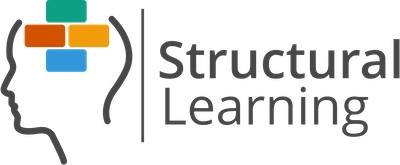Structural Learning is a new thinking tool for the classroom, a cognitive teaching strategy that uses building bricks to help students process information. Structural Learning helps students to remember and understand curriculum content; it also puts learners in a position to think critically and creatively. This, in turn, promotes cognitive development.
Cognitive development in children involves their ability to pay attention and how they think and use their memory, this is how information is stored. In order to store and retain information successfully, the activities children participate should have depth which leads to meaning creation and retaining more information. Depth is defined as "the meaningfulness extracted from the stimulus rather in terms of the number of analyses performed upon it" (Craik 1973, p.48). This therefore indicates that if students are able to think of the meaning of a content they are able to remember it longer, the meaning they give the content is their way of processing the information presented to them this will then be processed and retained in the mind. The levels of processing model (Craik and Lockhart, 1972) confirmed this notion that the “deeper information is processed, the longer a memory trace will last” (Mcleod, 2007). This confirms that structural learning aids student’s memory in providing meaning and this in turn supports them to remember any subject taught.
Information can be processed in three ways, they are broken down into two main processes. The first one is shallow processing, and there are two forms of processing that comes under shallow processing. These are Structural processing, this type of process is not deep because information takes into consideration only the appearance, how words or letters look. The other shallow processing is phonemic processing this is mainly sound and relies on rehearsal to retain in the memory. These are all shallow and short- term ways of comprehending, this will not enable students to remember information for longer. Deep processing involves semantic processing where encoding is more meaningful, linking a picture to what you know and then creating a meaningful conclusion; this therefore leads to better memory long term (McLeod,2007). This is proof that deep processing is a more effective way of helping children to retain information as this makes a lasting impression on their minds; therefore they are more likely to keep up and remember what they learn.This also will lead to better application of what they hear and learn.
Structural Learning uses building bricks to help student’s process information, research shows that deep processing is more effective for long term memory and one’s ability to retain more information. Structural learning with the use of bricks, enables reworking, this is when information is paraphrased, method of loci this is where information is recalled in a list of what is to remembered and finally imagery where an image is created in the mind to help recollection, by then going a step further by explaining and making sense of it visually (McLeod,2007). All these processes are intended to help better memory and helping children to create meaning thus helping them to remember longer for the long term.
By incorporating Structural Learning with the current curriculum, students will be encouraged to explore different methods of learning. By creating meaning using Structural Learning, students are encouraged to think deeper, this takes more effort than shallow processing. Deeper processing according to Craik and Tulving (1975) leads to a more effective long term memory than shallow processing, which does not encourage the creation of meaning and deeper thinking.
In conclusion, Structural Learning using bricks encourage deeper processing rather than shallow processing; this is because depth and attention is required to build the bricks. Structural Leaning puts the student in control and in a position to think critically and creatively. This In turn helps students to remember and understand curriculum contents, this then supports and promote cognitive development as they are encourage to use depthand thinking deeper using their memory, drawing examples from daily life and what they know previously to build an image in their minds to create with the bricks. This leaves a better impression on their minds thus allowing them to retain more information and remembering long after exposure now and in the future.








